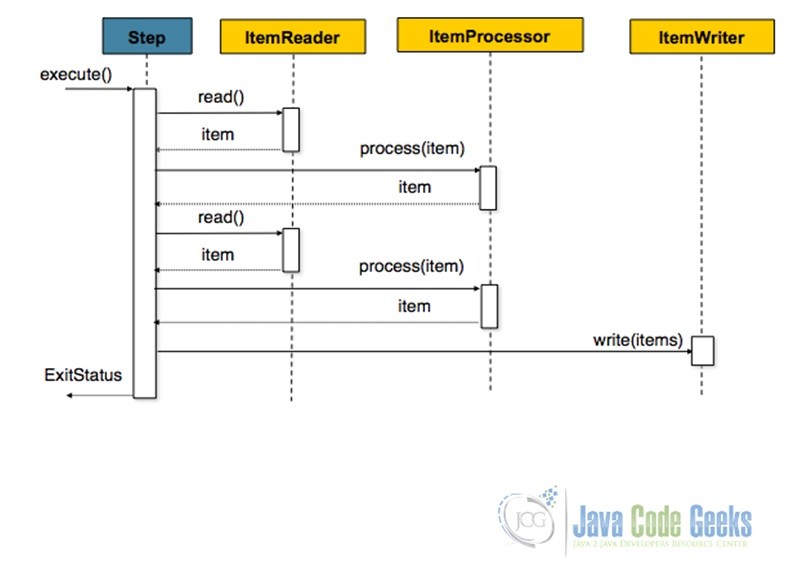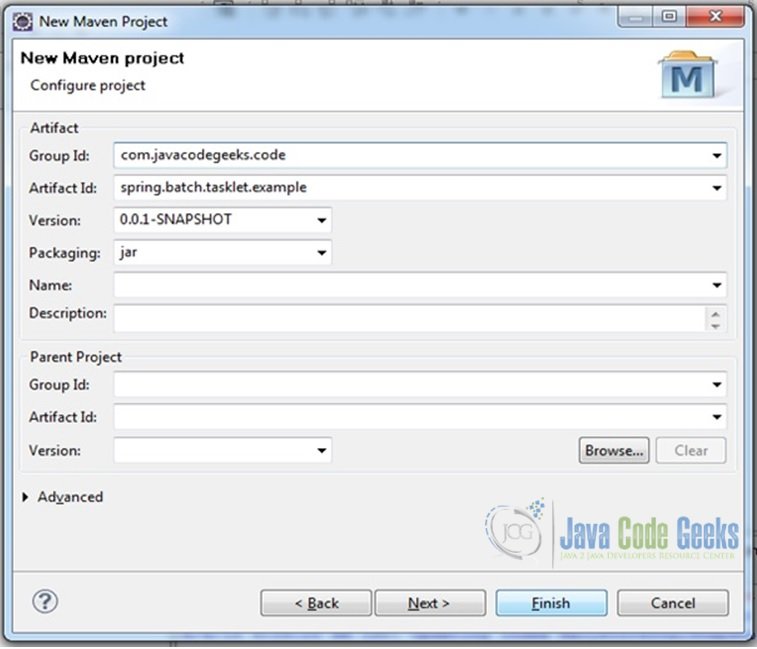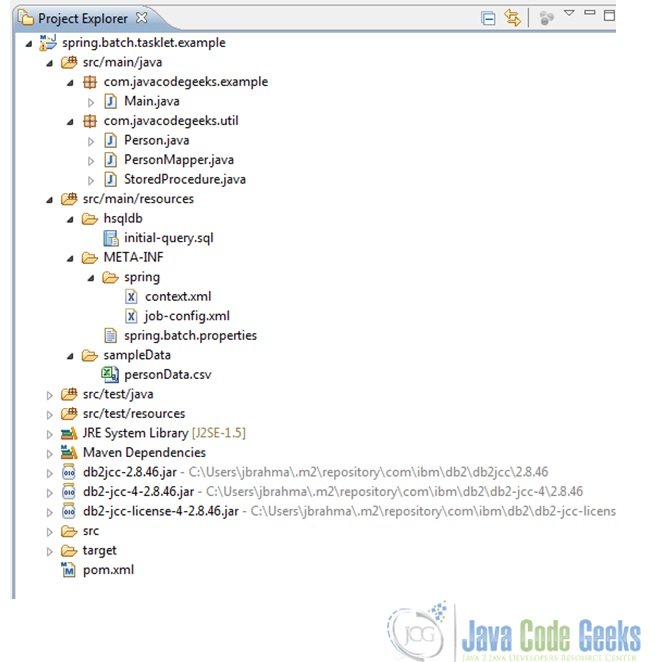Spring Batch Tasklet Example
Introduction
In this article we are going to present an example that demonstrates the working of Spring Batch Tasklet. We will configure a Spring Batch job that reads data from a CSV file into an HSQL database table and then in the Tasklet make a query into the table. As always, the example code is available for download at the end of the article.
But before we begin, a few questions need to be asked and answered. At the outset, what is Spring Batch? Well, it is a light-weight and robust framework for batch processing. And guess what? It is open-source; which is good! Now the question is when would one use batch processing? To answer that, consider a scenario where a large number of operations need to be performed, say process a million database records. And let’s say, such processing is a periodic activity happening, say weekly, monthly or daily!
Now we want this processing, which could run for hours on end, to run or be scheduled periodically with minimum human intervention. This is when Spring Batch comes to the rescue. And it does its bit in a pretty nice and efficient way as we will see in this example. But before we get our hands dirty, we will take a quick look at a couple of important elements of the Spring Batch Framework. Of course, there are many more elements of interest and importance which could be looked up from the official Spring Batch Documentation. The article is organized as listed below. Feel free to jump to any section of choice.
Table Of Contents
1. Spring Batch Framework: Key Concepts
The following section skims through the key concepts of the framework.
1.1. Jobs
The Spring Batch documentation describes it as an entity that encapsulates the entire batch process.Think of a Job as an activity, a task; say, processing a million database records. Now performing this one activity involves several smaller activities, like reading the data from the database, processing each record and then writing that record to a file or in a database etc. So a Job basically holds all these logically related bunch of activities that identify a flow or a sequence of actions. A Job is actually an interface and SimpleJob is one of its simplest implementations provided by the framework. The batch namespace abstracts away these details and allows one to simply configure a job using the <job/> tags as shown below.
<job id="processDataJob" job-repository="job-repo" restartable="1">
<step id="dataload" next="processLoad"/>
<step id="processLoad"/>
</job>
Points to notice about the above job configuration
- It has to have an id/name
- A JobRepository can be specified explicitly as is done above. By default, it takes the job-repository name as
jobRepository. As the name suggests, it offers the persistence mechanism in the framework. - The ‘restartable’ property specifies whether the Job once completed could be restarted or not. It is scoped over all the Steps in the Job. It takes a default value of ‘true’.
- And then a group of Steps has to be configured. Observe how an order of execution of the Steps can be specified using the attribute next
1.2. Steps
Spring Batch defines Steps as domain objects that identify an independent, sequential phase of the Job. In other words all the details needed to do the actual batch processing are encapsulated in Steps. Hence, each Job can have one or more Steps. Each Step comprises three elements: ItemReader, ItemProcessor and ItemWriter as shown in the diagram below taken from the Spring Batch Documentation.
1.2.1. ItemReader
The ItemReader is an abstraction that provides the means by which data is read one item at a time into the Step. It can retrieve the input from different sources and there are different implementations floated by the framework as listed in the appendix. The input sources are broadly categorized as follows:
- Flat Files: where the data units in each line are separated by tags, spaces or other special characters
- XML Files: the XML File Readers parse, map and validate the data against an XSD schema
- Databases: the readers accessing a database resource return result-sets which can be mapped to objects for processing
1.2.2. ItemProcessor
The ItemProcessor represents the business processing of the data read from the input source. Unlike the ItemReader and ItemWriter, it is an optional attribute in the Step configuration. It is a very simple interface that simply allows passing it an object and transforming it to another with the application of the desired business logic.
ItemProcessor Interface
public interface ItemProcessor<I,O> {
O process(I item) throws Exception;
}
1.2.3. ItemWriter
An ItemWriter is a pretty simple interface which represents the reverse functionality of the ItemReader. It receives a batch or chunk of data that is to be written out either to a file or a database. So a bunch of different ItemWriters are exposed by the framework as listed in this Appendix.
Note that ItemReaders and ItemWriters can also be customized to suit one’s specific requirements.
So much for what comprises Steps. Now coming to the processing of Steps; it can happen in two ways: (i) Chunks and (ii) Tasklets.
1.2.4.Chunk Processing
Chunk-oriented processing is the most commonly encountered operation style in which the processing happens in certain ‘chunks’ or blocks of data defined by a transaction boundary. That is, the itemReader reads a piece of data which are then fed to the itemProcessor and aggregated till the transaction limit is reached. Once it does, the aggregated data is passed over to the itemWriter to write out the data. The size of the chunk is specified by the ‘commit-interval’ attribute as shown in the snippet below.
Step
<step id="springBatchCsvToXmlProcessor"> <chunk reader="itemReader" writer="xmlWriter" commit-interval="10"></chunk> </step>
The following diagram from the Spring Documentation summarizes the operation pretty well.

1.2.5.TaskletStep Processing
Now consider a scenario which involves just one task, say invoking a Stored Procedure or making a remote call or anything that does not involve an entire sequence of reading and processing and writing data but just one operation. Hence, we have the Tasklet which is a simple interface with just one method execute. The following code snippet shows how to configure a TaskletStep.
TaskletStep
<step id="step1">
<tasklet ref="myTasklet"/>
</step>
Points worth a note in the above configuration are as follows:
- The ‘ref’ attribute of the <tasklet/> element must be used that holds a reference to bean defining the Tasklet object
- No <chunk/> element should be used inside the <tasklet/>
- The TaskletStep repeatedly calls the
executemethod of the implementing class until it either encounters aRepeatStatus.FINISHEDflag or an exception. - And each call to a Tasklet is wrapped in a transaction
element
2. Tasklet Example
Now that we have had a quick briefing on the concepts of Jobs,Steps,Chunk-Processing and Tasklet-Processing; we should be good to start walking through our Tasklet example. We will be using Eclipse IDE and Maven. And we will use the in-memory database HSQL. In this example, we will simply read from a CSV file and write it to an HSQL database table. And once the operation gets done, we will use the Tasklet to make a query into the database table. Simple enough! Let’s begin.
2.1 Tools used
- Maven 2.x
- Eclipse IDE
- JDK 1.6
2.2 Create a Maven Project
- Fire up Eclipse from a suitable location/folder
- Click on File-> New->Project..
- From the pop-up box choose Maven->Maven Project->Next
- In the next window that comes up, choose the creation of a simple project skipping archetype selection and then click Next.
-
In the next screen, just supply the
groupIdandartifactIdvalues as shown in the screenshot below and click on ‘Finish’ - This should give the following final project structure
- Then after add some more folders and packages so that we have the following project created.
2.3 Add Dependencies
In the pom.xml file add the following dependencies. Note that Spring-Batch internally imports Spring-core etc. Hence, we are not importing Spring-Core explicitly.
pom.xml
<project xmlns="http://maven.apache.org/POM/4.0.0" xmlns:xsi="http://www.w3.org/2001/XMLSchema-instance" xsi:schemaLocation="http://maven.apache.org/POM/4.0.0 http://maven.apache.org/xsd/maven-4.0.0.xsd">
<modelVersion>4.0.0</modelVersion>
<groupId>com.javacodegeeks.code</groupId>
<artifactId>spring.batch.tasklet.example</artifactId>
<version>0.0.1-SNAPSHOT</version>
<properties>
<spring.batch.version>3.0.3.RELEASE</spring.batch.version>
<spring.jdbc.version>4.0.5.RELEASE</spring.jdbc.version>
<commons.version>1.4</commons.version>
<hsql.version>1.8.0.7</hsql.version>
</properties>
<dependencies>
<dependency>
<groupId>org.springframework.batch</groupId>
<artifactId>spring-batch-core</artifactId>
<version>${spring.batch.version}</version>
</dependency>
<dependency>
<groupId>org.springframework</groupId>
<artifactId>spring-jdbc</artifactId>
<version>${spring.jdbc.version}</version>
</dependency>
<dependency>
<groupId>commons-dbcp</groupId>
<artifactId>commons-dbcp</artifactId>
<version>${commons.version}</version>
</dependency>
<dependency>
<groupId>hsqldb</groupId>
<artifactId>hsqldb</artifactId>
<version>${hsql.version}</version>
</dependency>
</dependencies>
</project>
2.4 Add db2* jars
The db2-jcc* jars are required to connect to the HSQL database.
Right click on the project-> Java Build Path->Libraries->Add External jars
Choose the jar files and click ‘OK’. These jars are available with the example code for download.
2.5 HSQL Table Creation
Under src/main/resources/hsqldb, add a file initial-query with the following table creation query in it
initial-query
DROP TABLE IF EXISTS PERSON_DATA; CREATE TABLE PERSON_DATA( firstName VARCHAR(20), lastName VARCHAR(20), address VARCHAR(50), age INT, empId INT );
2.6 Supply Sample Data
Under src/main/resources, add a personData.csv file under the sampleData folder with some data. For example,
| firstName | lastName | address | age | empId |
|---|---|---|---|---|
| “Alex”, | “Borneo”, | “101, Wellington, London”, | 31, | 111390 |
| “Theodora”, | “Rousevelt”, | “2nd Cross, Virgina, USA”, | 25, | 111909 |
| “Artemisia”, | “Brown”, | “West Southampton,NJ”, | 23, | 111809 |
| “Cindrella”, | “James”, | “Middletown, New Jersey,” | 28, | 111304 |
2.7 Data Model
Next, create a simple POJO class Person.java with attributes as firstName, lastName etc and their getters and setters
Person.java
package com.javacodegeeks.util;
public class Person {
String firstName,lastName,address;
int age, empId;
public String getFirstName() {
return firstName;
}
public void setFirstName(String firstName) {
this.firstName = firstName;
}
public String getLastName() {
return lastName;
}
public void setLastName(String lastName) {
this.lastName = lastName;
}
public String getAddress() {
return address;
}
public void setAddress(String address) {
this.address = address;
}
public int getAge() {
return age;
}
public void setAge(int age) {
this.age = age;
}
public int getEmpId() {
return empId;
}
public void setEmpId(int empId) {
this.empId = empId;
}
@Override
public String toString(){
return firstName+" "+ lastName+" "+ address;
}
}
2.8 RowMapper
Next, we will need a PersonMapper.java class that maps the data to the POJO
PersonMapper.java
package com.javacodegeeks.util;
import java.sql.ResultSet;
import java.sql.SQLException;
import org.springframework.jdbc.core.RowMapper;
public class PersonMapper implements RowMapper {
public Person mapRow(ResultSet rs, int rowNum) throws SQLException {
Person person = new Person();
person.setFirstName(rs.getString("firstName"));
person.setLastName(rs.getString("lastName"));
person.setAddress(rs.getString("address"));
person.setAge(rs.getInt("age"));
person.setEmpId(rs.getInt("empId"));
return person;
}
}
2.9 Tasklet
Now we will create a class StoredProcedure.java that implements the Tasklet. This is what will be executed from our tasklet code. On second thoughts, probably the class should have been named more appropriately. Anyways, so here is the class
StoredProcedure.java
package com.javacodegeeks.util;
import java.util.ArrayList;
import java.util.List;
import javax.sql.DataSource;
import org.springframework.batch.core.StepContribution;
import org.springframework.batch.core.scope.context.ChunkContext;
import org.springframework.batch.core.step.tasklet.Tasklet;
import org.springframework.batch.repeat.RepeatStatus;
import org.springframework.jdbc.core.JdbcTemplate;
public class StoredProcedure implements Tasklet{
private DataSource dataSource;
private String sql;
public DataSource getDataSource() {
return dataSource;
}
public void setDataSource(DataSource dataSource) {
this.dataSource = dataSource;
}
public String getSql() {
return sql;
}
public void setSql(String sql) {
this.sql = sql;
}
public RepeatStatus execute(StepContribution contribution,
ChunkContext chunkContext) throws Exception {
List result=new ArrayList();
JdbcTemplate myJDBC=new JdbcTemplate(getDataSource());
result = myJDBC.query(sql, new PersonMapper());
System.out.println("Number of records effected: "+ result);
return RepeatStatus.FINISHED;
}
}
2.10 Job Configuration
Ok, so now we are nearing our goal. We will configure the job that reads data from a CSV file into a database table and then calls the tasklet in job-config.xml as follows.
job-config.xml
<?xml version="1.0" encoding="UTF-8"?>
<beans xmlns="http://www.springframework.org/schema/beans"
xmlns:aop="http://www.springframework.org/schema/aop" xmlns:tx="http://www.springframework.org/schema/tx"
xmlns:batch="http://www.springframework.org/schema/batch" xmlns:task="http://www.springframework.org/schema/task"
xmlns:file="http://www.springframework.org/schema/integration/file"
xmlns:integration="http://www.springframework.org/schema/integration"
xmlns:p="http://www.springframework.org/schema/p" xmlns:xsi="http://www.w3.org/2001/XMLSchema-instance"
xmlns:context="http://www.springframework.org/schema/context"
xmlns:util="http://www.springframework.org/schema/util"
xsi:schemaLocation="http://www.springframework.org/schema/beans
http://www.springframework.org/schema/beans/spring-beans.xsd
http://www.springframework.org/schema/integration
http://www.springframework.org/schema/integration/spring-integration.xsd
http://www.springframework.org/schema/integration/file
http://www.springframework.org/schema/integration/file/spring-integration-file.xsd
http://www.springframework.org/schema/beans
http://www.springframework.org/schema/beans/spring-beans.xsd
http://www.springframework.org/schema/batch
http://www.springframework.org/schema/batch/spring-batch.xsd
http://www.springframework.org/schema/context
http://www.springframework.org/schema/context/spring-context.xsd
http://www.springframework.org/schema/aop
http://www.springframework.org/schema/aop/spring-aop.xsd
http://www.springframework.org/schema/tx
http://www.springframework.org/schema/tx/spring-tx.xsd
http://www.springframework.org/schema/util
http://www.springframework.org/schema/util/spring-util.xsd
http://www.springframework.org/schema/task
http://www.springframework.org/schema/task/spring-task.xsd">
<!-- Pojo class used as data model -->
<bean id="personModel" class="com.javacodegeeks.util.Person" scope="prototype"/>
<!-- Define the job -->
<job id="springBatchCsvToDbJob" xmlns="http://www.springframework.org/schema/batch">
<step id="springBatchCsvToDbProcessor" next="callStoredProcedure">
<tasklet >
<chunk reader="itemReader" writer="itemWriter" commit-interval="10"></chunk>
</tasklet>
</step>
<step id="callStoredProcedure">
<tasklet ref="storedProcedureCall"/>
</step>
</job>
<bean id="storedProcedureCall" class="com.javacodegeeks.util.StoredProcedure">
<property name="dataSource" ref="dataSource"/>
<property name="sql" value="${QUERY}"/>
</bean>
<!-- Read data from the csv file-->
<bean id="itemReader" class="org.springframework.batch.item.file.FlatFileItemReader">
<property name="resource" value="classpath:sampleData/personData.csv"></property>
<property name="linesToSkip" value="1"></property>
<property name="lineMapper">
<bean class="org.springframework.batch.item.file.mapping.DefaultLineMapper">
<property name="lineTokenizer">
<bean class="org.springframework.batch.item.file.transform.DelimitedLineTokenizer">
<property name="names" value="firstName,lastName,address,age,empId"></property>
</bean>
</property>
<property name="fieldSetMapper">
<bean class="org.springframework.batch.item.file.mapping.BeanWrapperFieldSetMapper">
<property name="prototypeBeanName" value="personModel"></property>
</bean>
</property>
</bean>
</property>
</bean>
<bean id="itemWriter" class="org.springframework.batch.item.database.JdbcBatchItemWriter">
<property name="dataSource" ref="dataSource"></property>
<property name="sql">
<value>
<![CDATA[
insert into PERSON_DATA(firstName,lastName,address,age,empId)
values (:firstName,:lastName,:address,:age,:empId)
]]>
</value>
</property>
<property name="itemSqlParameterSourceProvider">
<bean class="org.springframework.batch.item.database.BeanPropertyItemSqlParameterSourceProvider"/>
</property>
</bean>
</beans>
2.11 Context Configuration
Next, we will set up the context.xml file that defines the jobRepository,jobLauncher,transactionManager etc.
- Notice how the HSQL database has been set-up in the
dataSource - Also, take note of how the initial queries to be executed on the
dataSourcehave been specified - We have also configured the property-placeholder in it so that the values passed in
spring.batch.propertiesfile is accessible. - Also, we have simply imported the
job-config.xmlfile in it, so that loading just this one file in the application context is good enough
context.xml
<beans xmlns="http://www.springframework.org/schema/beans"
xmlns:xsi="http://www.w3.org/2001/XMLSchema-instance"
xmlns:jdbc="http://www.springframework.org/schema/jdbc"
xsi:schemaLocation="
http://www.springframework.org/schema/beans
http://www.springframework.org/schema/beans/spring-beans-4.0.xsd
http://www.springframework.org/schema/jdbc
http://www.springframework.org/schema/jdbc/spring-jdbc.xsd">
<import resource="classpath:META-INF/spring/job-config.xml"/>
<bean
class="org.springframework.beans.factory.config.PropertyPlaceholderConfigurer">
<property name="locations">
<list>
<value>classpath:META-INF/spring.batch.properties
</value>
</list>
</property>
<property name="searchSystemEnvironment" value="true" />
<property name="systemPropertiesModeName" value="SYSTEM_PROPERTIES_MODE_OVERRIDE" />
<property name="ignoreUnresolvablePlaceholders" value="true" />
</bean>
<bean id="jobRepository"
class="org.springframework.batch.core.repository.support.JobRepositoryFactoryBean">
<property name="dataSource" ref="dataSource" />
<property name="transactionManager" ref="transactionManager" />
<property name="databaseType" value="hsql" />
</bean>
<bean id="jobLauncher"
class="org.springframework.batch.core.launch.support.SimpleJobLauncher">
<property name="jobRepository" ref="jobRepository" />
</bean>
<bean id="transactionManager"
class="org.springframework.batch.support.transaction.ResourcelessTransactionManager" />
<bean id="dataSource" class="org.apache.commons.dbcp.BasicDataSource"
lazy-init="true" destroy-method="close">
<property name="driverClassName" value="org.hsqldb.jdbcDriver" />
<property name="url"
value="jdbc:hsqldb:file:src/test/resources/hsqldb/batchcore.db;shutdown=true;" />
<property name="username" value="sa" />
<property name="password" value="" />
</bean>
<!-- create job-meta tables automatically -->
<!-- Note: when using db2 or hsql just substitute "mysql" with "db2" or "hsql".
For example, .../core/schema-drop-db2.sql -->
<jdbc:initialize-database data-source="dataSource">
<jdbc:script location="org/springframework/batch/core/schema-drop-hsqldb.sql" />
<jdbc:script location="org/springframework/batch/core/schema-hsqldb.sql" />
<jdbc:script location="classpath:hsqldb/initial-query.sql" />
</jdbc:initialize-database>
</beans>
2.12 Properties File
Add a properties file spring.batch.properties under src/main/resources/META-INF and put the query we want to be executed as part of the tasklet as a property value as shown here.
spring.batch.properties
QUERY=select * from PERSON_DATA where age=31
2.13 Run the Application
Now we are all set to fire the execution. In the Main.java file, write down the following snippet and run it as a Java application.
Main.java
package com.javacodegeeks.example;
import org.springframework.batch.core.Job;
import org.springframework.batch.core.JobExecution;
import org.springframework.batch.core.JobParameters;
import org.springframework.batch.core.launch.JobLauncher;
import org.springframework.context.ApplicationContext;
import org.springframework.context.support.ClassPathXmlApplicationContext;
public class Main {
public static void main(String[] args) {
ApplicationContext ctx = new ClassPathXmlApplicationContext("classpath:META-INF/spring/context.xml");
Job job = (Job) ctx.getBean("springBatchCsvToDbJob");
JobLauncher jobLauncher = (JobLauncher) ctx.getBean("jobLauncher");
try{
JobExecution execution = jobLauncher.run(job, new JobParameters());
System.out.println(execution.getStatus());
}catch(Exception e){
e.printStackTrace();
}
}
}
2.13 Output
On running the application, we will find the following output.
Jun 8, 2015 9:05:37 AM org.springframework.batch.core.launch.support.SimpleJobLauncher run
INFO: Job: [FlowJob: [name=springBatchCsvToDbJob]] launched with the following parameters: [{}]
Jun 8, 2015 9:05:37 AM org.springframework.batch.core.job.SimpleStepHandler handleStep
INFO: Executing step: [springBatchCsvToDbProcessor]
Jun 8, 2015 9:05:37 AM org.springframework.batch.core.job.SimpleStepHandler handleStep
INFO: Executing step: [callStoredProcedure]
Number of records effected: [Alex Borneo 101, Wellington, London]
Jun 8, 2015 9:05:37 AM org.springframework.batch.core.launch.support.SimpleJobLauncher run
INFO: Job: [FlowJob: [name=springBatchCsvToDbJob]] completed with the following parameters: [{}] and the following status: [COMPLETED]
COMPLETED
3. Download Example
This brings us to the end of this example; hope it was an interesting and useful read. As promised, the example code is available for download below.
You can download the full source code of this example here : spring.batch.tasklet.example









Really helpful stuff.
Thanks Joormana
Hi there,
Very informative article.
I realised that in the chunk explanation, it mentioned that no chunks should be in tasklets. But in your tasklet example, it included a chunk. Did I understand that wrongly or was it a typo?